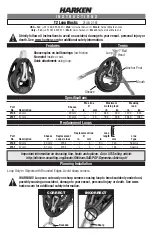
Universal Calibrating Machine
(UCM) Manual
(PM-5201)
Morehouse Instrument Company, Inc.
1742 Sixth Ave., York, PA 17403-2675 USA
Phone: (717) 843-0081
www.mhforce.com
Page 26
Rev. 11/2021
c) Replace the load ball (or bearing plate) on top of the reference standard, and lower the upper yoke platen
onto the reference standard until the tie bar locking collars are clear of the upper machine platen. Note: Check
to see that the test instrument is not under load, and that the tie bars are not touching the upper machine
platen.
d) Again, read the indicated deflection of the reference standard.
e) Subtract the deflection reading obtained in step b) from that obtained in step d), and convert this difference
to pounds. This is the nominal tare load on the reference standard.
If the nominal tare load, as determined in the above procedure, falls within the range of acceptable accuracy
of the calibration standard in use, then this value may be used directly. If it does not, then substitute a low
-
er-capacity reference standard. If possible, use one whose rated capacity only slightly exceeds the nominal tare
load. Then repeat steps a) through e). After the force attributable to the tare load (F1) has been determined
within acceptable accuracy limits, place the original reference standard into the calibrating machine.
To apply a force (FX) to a test instrument, the reference standard must indicate (F1 + FX). In other words, the
force (FX) applied to the test instrument is the difference between the total force (FT) indicated by the refer
-
ence standard and the tare load (F1). Mathematically, this may be expressed as:
FX = FT - F1
In some types of calibration, the resulting error may be too small to justify the extra effort of compensating for
the tare load. In calibrating test instruments with a rated capacity substantially less than that of the calibrating
machine, and with a rated accuracy of 1% or less, the tare load effect usually must be taken into consideration.









































